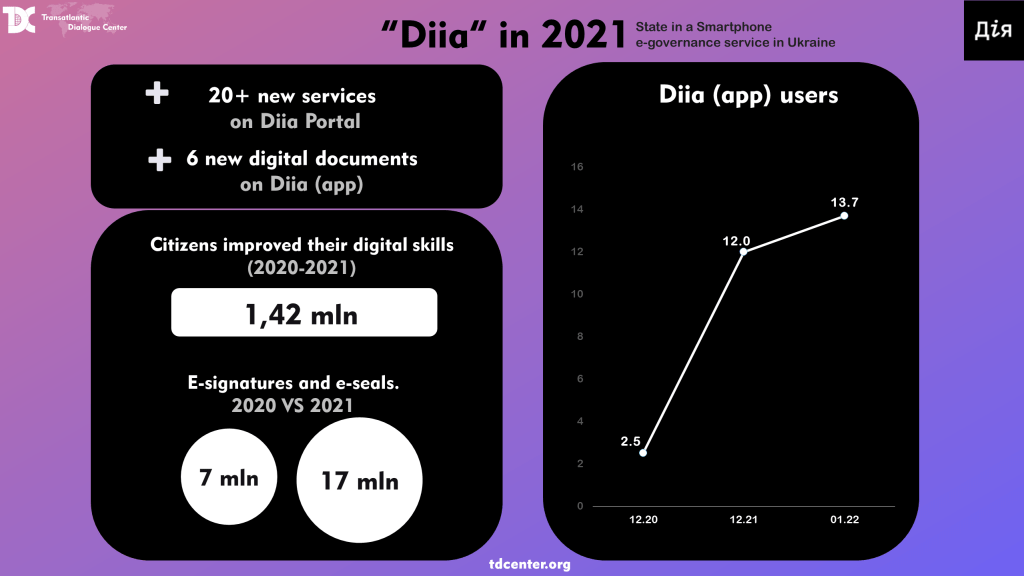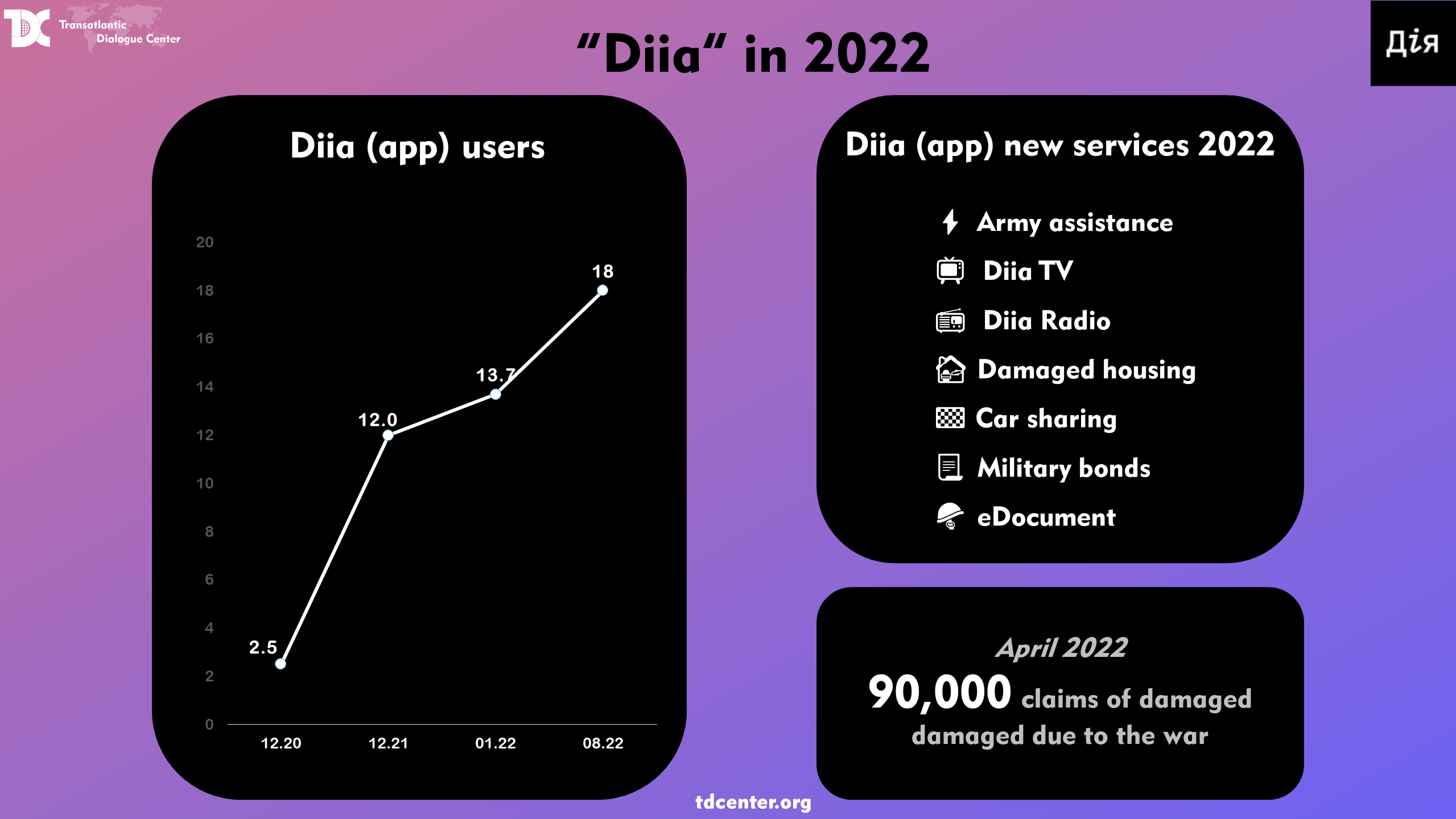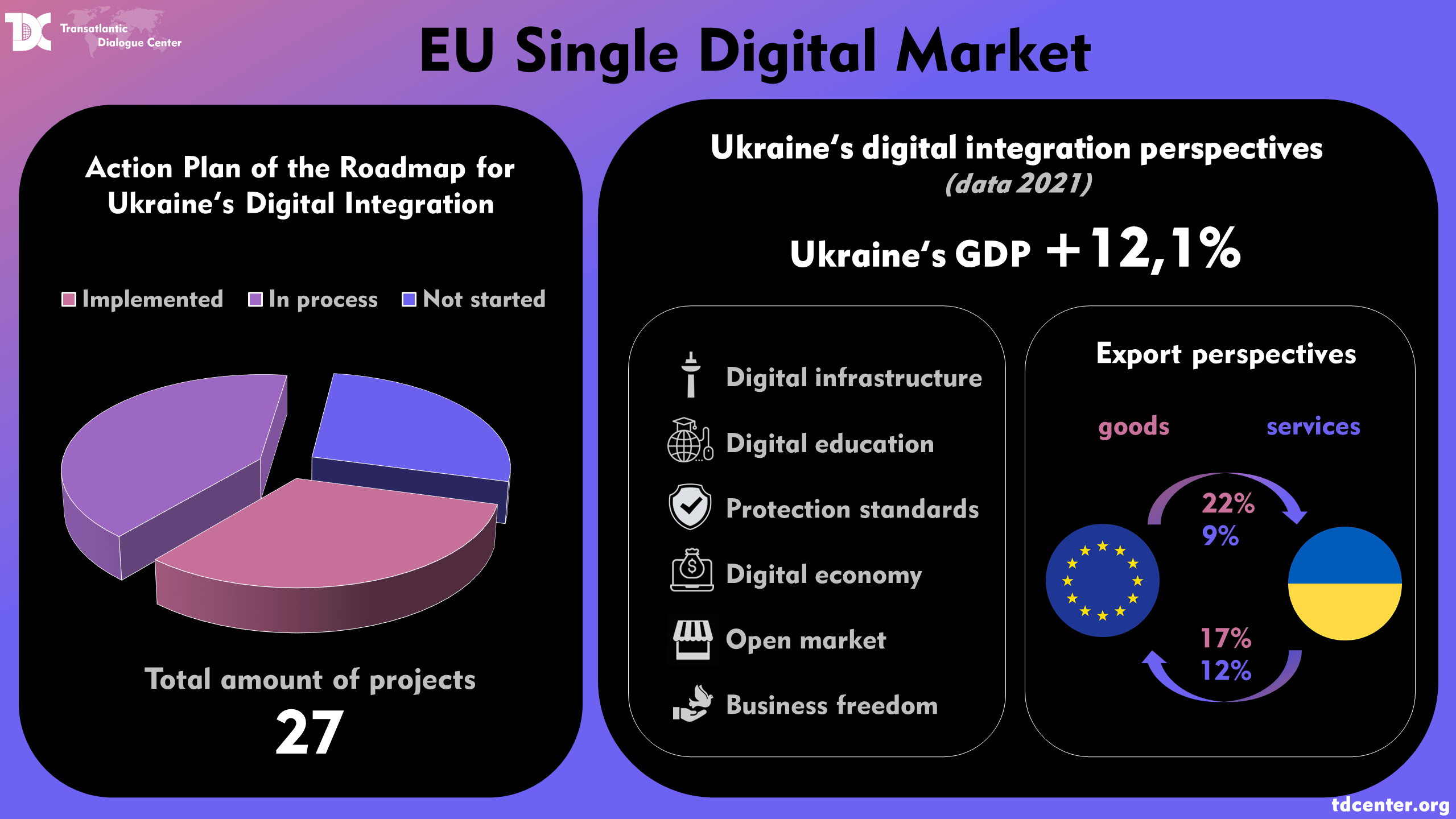343 KB
3 years of painstaking efforts followed by ups and downs. Initial economic and political instability, COVID-19, and the war, but not one step back – only one hundred steps forward toward the EU. In 3 years, Ukraine achieved a higher level of digitalization, in particular, that of state services, than a great number of highly developed countries. Thus, Ukraine proved that it is worth being a part of the EU democracies.
Get to know Diia
The E-state is rapidly growing, involving more and more new services and opportunities. Diia (an acronym for Ukrainian “Diia: Derzhava i Ya”, literally “State and Me”) is an e-government service in Ukraine. It provides an absolutely new level of communication between the state and citizens. Diia started to gain international recognition back in 2020, with Red Dot Design Award. And then in 2021 and 2022, the portal got awards for its mobile application and interface. Now Diia receives a lot of positive feedback from foreigners who learnt about it thanks to Ukrainian refugees.
In 2020, Mykhailo Fedorov, Deputy Prime Minister of Ukraine, Minister of Digital Transformation of Ukraine, said: “We have already created the Diia mobile application and e-services portal implemented the first digital passports in the world, and launched business registration in 15 minutes. We are creating new digital opportunities for Ukrainians and are ready to exchange experience with other nations.” Indeed, in September 2022, it was announced that The Ministry of Digital Transformation of Ukraine would help Estonia create an application based on “Diia” to “build the best digital states in the world together”.
More users: young and elderly
Since then, Diia became a Ukrainian symbol and a story of success. All the necessary documents are at hand. You can pay taxes, check in at a hotel, issue a banking card, and sign any document in just a few clicks. Such an efficient tool initially became popular among Ukrainian youth: the most progressive stratum of society. At first, it was difficult to engage a lot of people in the usage due to a lack of digital skills among the population. “Diia. Digital Education” platform was created and in 2 years (2020-2021) 1,42 million citizens improved their skills above the basic level.

Elderly people also had to get used to new technology: at first, due to the opportunity to draw up a pension online, then in order to receive eSupport (financial aid from the state for the vaccination). With the war outbreak, it became possible to get a pension supplement in Diia as well. No queues, no time waste, and no long bureaucratic processes. Sounds good for both active youngsters and busy seniors. Such conditions encouraged more and more people to download the Diia app, and at the beginning of 2022, the number of users reached 13,7 million. Harsh war circumstances urged even more Ukrainians to join the app and by the end of August 2022, there were 18 million users of the Diia app.
Digital breakthrough in time of war
With the outbreak of hostilities, the digital transformation did not step forward but rocketed. A powerful IT army was formed, and Ukraine has already received valuable experience in the usage of technology during the war. For example, artificial intelligence is applied to recognize the identities of the dead while Starlink systems are used to restore signal in the war-affected areas. The first state crypto fund was established, and the government carried out numerous vital services for the citizens in need.
Overall, facing the threat, Ukrainians did not retreat but started to work together even more diligently to work out quick and efficient decisions.
In the first month of the war, the Diia app launched several services, for instance issuing a statement about destroyed housing. That made it possible to record the damages caused by the Russian onslaught and receive financial support from the government in the future. The possibility to aid the army with donations has recently appeared and, as a result, tens of millions of UAH were funded to support the Ukrainian Armed Forces and territorial defense forces.
Diia made it easier and quicker for citizens to apply for state social benefits and issue the status of an internally displaced person. It would take weeks to stand in line for these documents, not to mention that it would be extremely dangerous. Another useful service is “eDocument”, a temporary document in the event of losing ID or other means of self-identification.
The implementation of the “eEnemy” chatbot played and plays an important role in gaining data on the displacement of Russian forces. By virtue of this service, the Ukrainian military revealed and eliminated numerous hostile groups. At the end of September, the number of Ukrainians that used this chatbot reached 370 hundred. The fact that people can just transmit data through Telegram and thus directly assist the army is fascinating.

Among other newly-implemented services are Diia.TV and Diia.Radio that provide official and reliable information even in temporarily occupied regions. News is a weapon and the one who fills the information space is one who wins, at least on the information battlefield. That is why these services are important, especially now.
Electronic pension certificates, residence permits, automatic LLC registration, car sharing, and payment of traffic fines were launched in the Diia app in the summer. Some English-language documents were also added. In fact, Ukrainian digital documents are gaining more and more recognition in Europe. A great example of this is “Diia pl” (an electronic document issued to Ukrainian citizens who crossed the Polish-Ukrainian border after February 24, 2022) that acquired the official status of a digital residence permit, and, in addition, the digital driver’s license and technical passport in “Diia” will be displayed in the Polish application mObywatel. Ukraine highly appreciates such a gesture from Poland.
Since 3 October, it has become possible to buy military bonds. In the first 3 days of the service’s operation, Ukrainians purchased military bonds worth 25 million UAH, that is, such sum was transferred to the needs of the armed forces. Preferential mortgages, car customs clearance, and car registration through Diia are now under development and soon will become available. The Verkhovna Rada approved the draft law on e-residency, which will make it possible to circumvent corruption schemes in migration services and attract foreign capital and investments in Ukraine.
Some concerns about Diia
From the very beginning, Diia faced several issues. Apart from the low level of technical literacy of the population, the challenge was the suspicion towards Diia. Certain members of society accused the service of a possible data leak, system insecurity, and request of too confidential information.
We should remember that the data in Diia is taken from already existing paper registers, which may not be safer than Diia. Indeed, initially, the app was a cause of concern, and there were risks, but over time the level of protection increased, with the appearance of new services and users. It cannot be denied that there are some cyber security problems in Ukraine. And this is one of the reasons why the country is so eager to become part of the EU Single Digital Market. Ukraine wants the data of its citizens to be protected, especially when there is an aggressor nearby who is trying with all his might to undermine Ukraine either from the outside or inside.
Towards the EU
From the very beginning, the digitalization of Ukraine was developed under the motto of European integration, and towards the idea of the EU Single Digital Market. More developed digital infrastructure, digital economy, and higher business freedom are among the opportunities of being in the Single Digital Market. And that is the objective of Ukraine.
In 2021, according to the research conducted by the Trade+ International Trade Research Center and the Ukrainian Center for European Policy, Ukraine’s integration into the EU’s Single Digital Market will lead to a 12.1% increase in Ukraine’s GDP as well as to general positive trends in bilateral trade.

In 2018, Ukraine and the EU agreed on the Roadmap for integration into the Single Digital Market, one that is constantly updated and provides the realization of main EU digital standards. Ukraine was transforming its economy and reforming IT education and a lot of projects were implemented so that the Ukrainian legislation complied with the EU requirements.
In July 2022, the European Union published an annual report on the implementation of the Association Agreement in Ukraine, encompassing the December 1, 2020 – February 24, 2022 period of research. The EU claimed that Ukraine has made the most progress in the areas of digital transformation and energy. For instance, there were adopted laws on electronic communications, the development of telecommunication networks, and on electronic trust services.
What is more, Ukraine became one of the first countries whose digital COVID-19 certificate was recognized by the EU. The report states that the digital transformation of Ukraine contributes to more efficient and transparent governance and the fight against corruption. The Ukraine-EU Association Council on September 5 also highly praised the digital reforms in Ukraine and emphasized the possibility of the abolition of roaming charges between the EU and Ukraine.
Ukraine is moving to the “digital” EU no matter what. The digital transformations began only 3 years ago, and the current state of affairs indicates a huge leap in the development and engagement of citizens to state services. And the Ukrainians’ persistence in the face of war only accelerated the entire process of Ukrainian integration, bringing the state closer to the EU, in the digitalization field in particular, and in other areas in general.